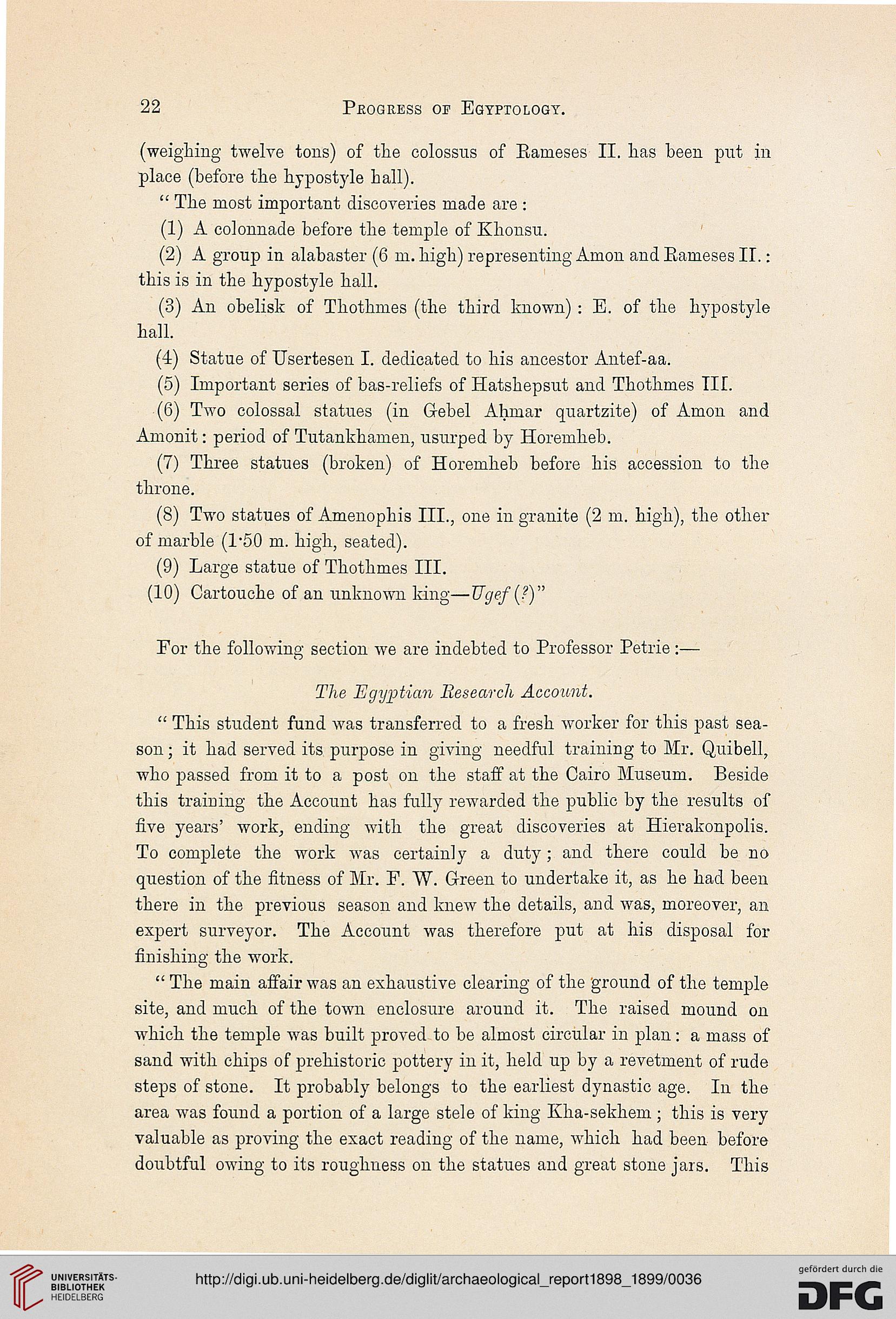22
Progress op Egyptology.
(weighing twelve tons) of the colossus of Barneses II. has been put in
place (before the hypostyle ball).
" The most important discoveries made are :
(1) A colonnade before the temple of Khonsu.
(2) A group in alabaster (6 m. high) representing Amon and Barneses II.:
this is in the hypostyle hall.
(3) An obelisk of Thothmes (the third known) : E. of the hypostyle
hall.
(4) Statue of Usertesen I. dedicated to his ancestor Antef-aa.
(5) Important series of bas-reliefs of Hatsbepsut and Thothmes III.
(6) Two colossal statues (in G-ebel Ahmar quartzite) of Amon and
Amonit: period of Tutankhamen, usurped by Horemheb.
(7) Three statues (broken) of Horemheb before his accession to the
throne.
(8) Two statues of Amenophis III., one in granite (2 m. high), the other
of marble (P50 m. high, seated).
(9) Large statue of Thothmes III.
(10) Cartouche of an unknown king—Ugef(?)"
For the following section we are indebted to Professor Petrie :—
The Egyptian Research Account.
" This student fund was transferred to a fresh worker for this past sea-
son ; it had served its purpose in giving needful training to Mr. Quibell,
who passed from it to a post on the staff at the Cairo Museum. Beside
this training the Account has fully rewarded the public by the results of
five years' work, ending with the great discoveries at Hierakonpolis.
To complete the work was certainly a duty; and there could be no
question of the fitness of Mr. F. W. Green to undertake it, as he had been
there in the previous season and knew the details, and was, moreover, an
expert surveyor. The Account was therefore put at his disposal for
finishing the work.
" The main affair was an exhaustive clearing of the ground of the temple
site, and much of the town enclosure around it. The raised mound on
which the temple was built proved to be almost circular in plan: a mass of
sand with chips of prehistoric pottery in it, held up by a revetment of rude
steps of stone. It probably belongs to the earliest dynastic age. In the
area was found a portion of a large stele of king Kha-sekhem ; this is very
valuable as proving the exact reading of the name, which had been before
doubtful owing to its roughness on the statues and great stone jars. This
Progress op Egyptology.
(weighing twelve tons) of the colossus of Barneses II. has been put in
place (before the hypostyle ball).
" The most important discoveries made are :
(1) A colonnade before the temple of Khonsu.
(2) A group in alabaster (6 m. high) representing Amon and Barneses II.:
this is in the hypostyle hall.
(3) An obelisk of Thothmes (the third known) : E. of the hypostyle
hall.
(4) Statue of Usertesen I. dedicated to his ancestor Antef-aa.
(5) Important series of bas-reliefs of Hatsbepsut and Thothmes III.
(6) Two colossal statues (in G-ebel Ahmar quartzite) of Amon and
Amonit: period of Tutankhamen, usurped by Horemheb.
(7) Three statues (broken) of Horemheb before his accession to the
throne.
(8) Two statues of Amenophis III., one in granite (2 m. high), the other
of marble (P50 m. high, seated).
(9) Large statue of Thothmes III.
(10) Cartouche of an unknown king—Ugef(?)"
For the following section we are indebted to Professor Petrie :—
The Egyptian Research Account.
" This student fund was transferred to a fresh worker for this past sea-
son ; it had served its purpose in giving needful training to Mr. Quibell,
who passed from it to a post on the staff at the Cairo Museum. Beside
this training the Account has fully rewarded the public by the results of
five years' work, ending with the great discoveries at Hierakonpolis.
To complete the work was certainly a duty; and there could be no
question of the fitness of Mr. F. W. Green to undertake it, as he had been
there in the previous season and knew the details, and was, moreover, an
expert surveyor. The Account was therefore put at his disposal for
finishing the work.
" The main affair was an exhaustive clearing of the ground of the temple
site, and much of the town enclosure around it. The raised mound on
which the temple was built proved to be almost circular in plan: a mass of
sand with chips of prehistoric pottery in it, held up by a revetment of rude
steps of stone. It probably belongs to the earliest dynastic age. In the
area was found a portion of a large stele of king Kha-sekhem ; this is very
valuable as proving the exact reading of the name, which had been before
doubtful owing to its roughness on the statues and great stone jars. This





